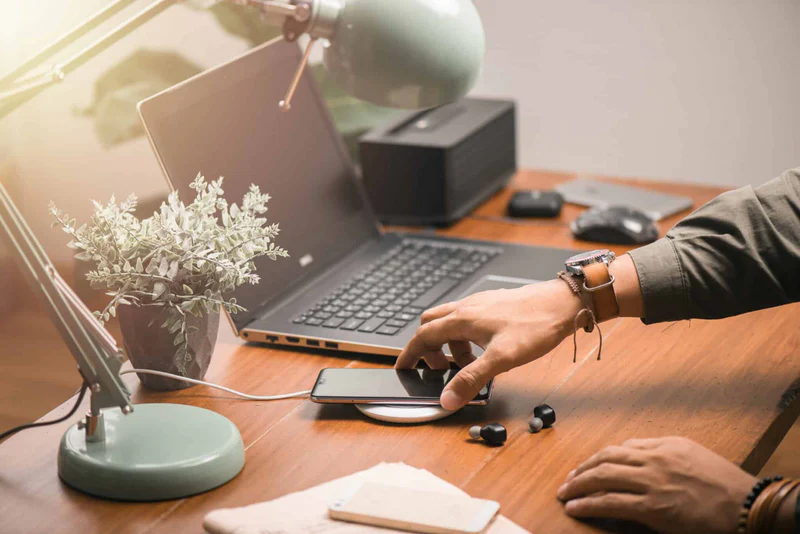The immediate pros of wireless charging are apparent for all to see. Smartphones and smartwatches can be easily rejuvenated when plopped onto charging pads, eliminating the need for rummaging through messy tables and drawers for cables. As long as there’s a wireless charging pad at your destination, bringing along your device is all you need.

How does wireless charging work?
Tightly-coupled electromagnetic induction
Wireless charging occurs when electricity is transferred from the charging pad to device via a process known as electromagnetic induction, where a magnetic field is produced between the wireless charging transmitter and receiver. Electricity is generated when the generated magnetic field interacts with copper coils in the receiving device, thereby charging the battery.
The most common form of wireless charging today is a sub-category known as tightly-coupled electromagnetic inductive charging, where the transmitting and receiving copper coils must be aligned and within close proximity for effective charging. Any misalignment will significantly slow down charging or cause the process to cease altogether.
Is Wireless Charging Bad For Your Phone?
Heat generated From Wireless Charging
Wireless charging is commonly misunderstood to be harmful for phone batteries due to the heat it generates. While it’s true that electromagnetic induction produces more heat than conventional wired charging, effects from the produced heat can be mitigated with careful management.
Furthermore, phone batteries are typically separated from copper charging coils by a layer of thermal insulation. The result is that smartphone battery temperatures can typically be contained within safe limits under normal circumstances.
Does wireless charging impact battery charge cycles?
Battery charge cycles refer to the number of times a rechargeable battery can undergo complete charging before losing their ability to hold a charge. One charging cycle is completed when a battery goes from being completely charged to completely discharged. Charging a battery from 50% to 100% will therefore only use up half of a battery cycle. Because battery charge cycles are influenced by the number of times they are charged rather than the charging method, wireless charging will not harm a device’s battery.
The only thing that consumers have to worry about is constant charging throughout the day, or charging a device even after it reaches maximum charge carrying capacity. Whenever a battery is charged, energy released will cause lithium ions to move from the graphite layer to the lithium cobalt oxide later. Overcharging can cause damage in the long run by pulling out 100% more lithium ions and messing up the internal battery structure. Most smartphone battery management systems prevent this by blocking current from entering fully charged batteries even while they are connected to a charger.
Does wireless charging pose a safety hazard?
There have been reported instances of wireless chargers being recalled due to safety concerns. Reported risks include fire, electric shock, injuries, or damage to phone and surrounding property. As a result, manufacturers have also warned consumers about sleeping beside charging devices or placing them in poorly ventilated areas, such as beneath a blanket or pillow.
What precautions should be taken during wireless charging?
Safety can be compromised whenever foreign objects such as coins, credit cards, or other metal objects obstruct the space between transmitter and receiver. These foreign objects receive power from the generated magnetic field and dissipate it in the form of heat, which can create damage to both device and user.
For manufacturers and consumers, the most foolproof way to minimize risk is to ensure that their devices comply with recognized charging standards so that the necessary safeguard mechanisms are in place to shut down the charging process before things get out of hand.
3 Tips for a Longer Battery Life
A long-lasting smartphone battery life can improve your overall user experience, minimize device interruptions and prolong your device’s lifespan. Here’s how you can ensure your smartphone’s battery life is efficiently optimized:
Keep Your Battery Level Balanced
At all cost, try to maintain your phone’s battery level between 20% and 80%. This range is considered the optimal battery lifespan zone. It’s advisable not to repeatedly let your phone’s battery drop below 20% as this puts a strain on it. On the contrary, charging your smartphone 100% isn’t a healthy practice either.
Practice Cautious Wireless Charging
If you’re a fan of wireless charging, ensure not to always keep your phone on the charging pad. Just like wired chargers, leaving your phone on a wireless charging pad for extended periods can lead to overcharging and possible battery degradation.
Minimize Fast Charging
hough convenient, fast charging can negatively impact your smartphone battery’s health. The heat generated from fast charging might degrade your battery very quickly. Thus, it’s wise to minimize the use of fast charging and resort to it only when it’s absolutely crucial.